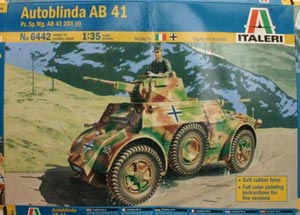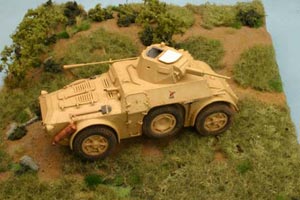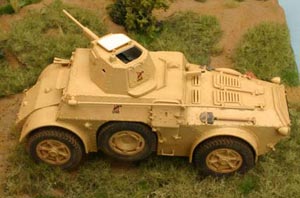| |
Italeri Autoblinda AB41 (6442)
by John Prigent

I picked this kit up for a weekend’s relaxation from adding aftermarket
parts to other models, since a the time of writing there are no accessories
for it other than sand-tyred wheels.
My first impressions were that the box held clean set of mouldings with
good instructions. This was almost, but not entirely, borne out in the
building. Most of the mouldings are clean, but there was more flash in
places than I expect from a brand-new mould and several sink marks. Fit
is not as good as I’d hoped, but tolerable apart from the driver’s
front plate to glacis joint. It seems that the plate fits over the glacis,
but the cutout for it is not quite deep enough. I suggest careful dry-fitting
of those two parts when the rest of the body is complete. All hatches
and doors are separate but have little internal detail and those annoying
ejector pin marks appear inside them. That’s not too bad, since
none of the other ejector pins are in places that can be seen after assembly.
Except those inside the wheel arches and they are shallow and almost hidden
anyway.

Building starts with the chassis, a neat little unit with detail on its
sides that is completely hidden when the armoured body is in place. Sides,
front and rear are attached to a central floor and two arched braces help
to get the sides vertical. All suspension and steering units are present
and so are the drive shafts. Take a moment to check which way round the
barake drums fit before cementing them, the location for the rie shafts
must go to the front of the front drums and to the rear of the rear drums
but you could be mislead by a quick glance at the instructions and get
them the wrong way round. The wheels have separate soft tyres with the
appropriate lettering on their outside faces. They slip easily onto the
wheels without stretching so shouldn’t present any splitting problem
years after the model is finished. This is achieved by the provision of
a lip on the inside face of each wheel as a “stop” while the
outside has rim detail that meets the edge of the tyre very well. Good
thinking by Italeri. The wheels are held by separate hub caps that can
be carefully fixed with them off the model, making is simple to paint
everything and fix the wheels afterwards.

The body is built separately from multiple plates and does need care
to get everything straight, but it has internal braces to help in this.
The hull machine gun is moveable with careful assembly, but it s muzzle
is too thin to allow drilling out – at least, for me. External fittings
are all separate parts, making for good definition, but I could not find
a positive location for the crowbar carried at the rear and the spades
need a rivet removed from under them before they can sit flat to the body.
Two jerrycans (Italicans?) are given to be fitted if you want them, and
there are “driver knows” poles for the German-marked options.
Apart from the glacis joint already mentioned the only real problem with
the hull is the fit of its doors. I had to adjust the hinges by careful
trimming to let both top and bottom sections sit parallel to each other,
and the absence of any internal detail will be horribly visible if you
leave either or both doors open. Maybe there’s a special version
to come with a resin interior set, like their announced German 6 wheeled
armoured car?
The turret, unlike the body, has internal detail in the form of a seat,
complete basic gun breech, co-ax MG, and sight plus traverse handle and
gearing to add to the turret ring and the inside arts of the roof periscope.
It also has open vision slits on its sides, though the ones in the hull
doors are moulded solid. Colours are called out for the internal parts
and the results look good through the open turret hatches – top
and rear hatches are separate.
Painting instructions are pictorial, in full colour and quoting Model
Master paints. All the decals provided are for vehicles in Sicily (1)
and mainland Italy (4). Two are in German service in 1944, to cater for
those who won’t buy any kit without black crosses. Two are Italian
in 1943, in the multi-colour scheme, and the fifth example is a plain
sand car of the Fascist Republic as seen in 1945.
Conclusion: this is a nice little kit, quite simple to build and a change
from the usual US/German selection. I have to suspect that other versions
are planned by Italeri, since there’s no reason to give location
holes to be opened from the inside for some parts unless they weren’t
carried on some other car – a desert-equipped AB41, or an AB42 perhaps?
The invisible detail on the sides of the chassis, and the presence of
unused locating holes on its arched braces, makes me wonder whether a
Sahariana open car is also a possible future release, but only time will
tell us. Recommended!
|
|